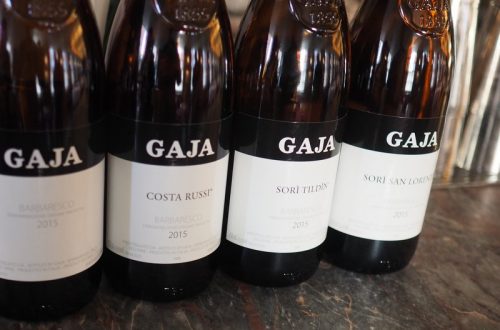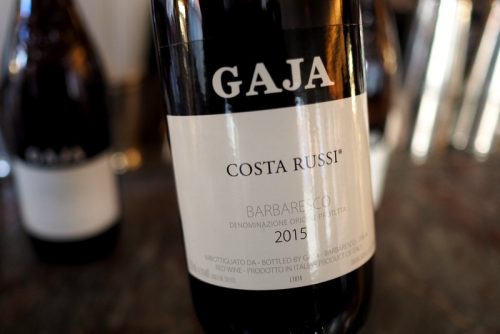
The articulate Gaia Gaja was in town to showcase her 2015 single vineyard Barbaresco releases, as well as the 2014 Barolos.
Perhaps Gaja’s greatest achievement as a producer has been to raise the status of Barbaresco, which has emerged a little from the shadow of its big brother Barolo. Langhe has two prestigious sub-regions: within the 10 000 hectares of vines in the region, there are 700 hectares of Barbaresco (with c. 180 producers), and 2000 hectares of Barolo (with c. 350 producers). ‘All the most respected wineries have been from Barolo, not Barbaresco, which was seen as a lesser version of Nebbiolo,’ says Gaia. ‘It took us three generations to show that Barbaresco has a beautiful potential. It is potentially more elegant, and it can still age.’
In a nice, rather un-Italian way, with the success of these two prestigious subregions, their borders haven’t grown. But the number of producers has increased, as more and more growers have begun bottling their own wines. Gaja were early adopters of this transition. ‘My family has always been growing grapes,’ says Gaia, ‘but 150 years ago they started becoming bottlers (in 1859). Every time they made some money they bought more land.’
They make wine only from their own vineyards. Gaia loves Nebbiolo, but acknowledges that it does have a difficult side. ‘Drinking Nebbiolo is like being hit in the face by a ballerina,’ she says, repeating one of her favourite quotes about the variety.

Gaia has now been working with her father for 15 years; he’s now 78 years old. She describes him as an instinctive optimist. ‘For him, improvement comes with change,’ she says. ‘It is a great opportunity to go forward.’ From May 2018 her brother has just started working in the winery, so there are five family members working together. They don’t have specific responsibilities, but share them all.
One of the slight clouds on the horizon is the way that land values have been pushed up so much, with vineyards in Barolo now hitting €4m/ha and those in Barbaresco €1.5 m/ha. ‘Investment has changed the climate,’ says Gaia.
In the vineyard, the goal is to have balanced, low vigour vines. How do they do this? ‘One way is old vines that are wise and disciplined,’ she says. ‘So we try to keep the vines alive as long as possible.’ Biodiversity in the vineyard is also a focus, with the goal of looking after the life in the soil. ‘Wine regions have become monoculture, and we are trying to cultivate biodiversity. Climate change isn’t helping because of dry conditions.’
Gaja have done lots of experimentation. They have planted 250 cypresses, which are now 10 years old. ‘The idea is to plant trees that are more compact: they can become a shelter for many birds,’ says Gaia, pointing out that even though they can be naughty and eat grapes, they are another element of biodiversity. ‘In 1999 we started composting, feeding the soil and not only the vines.’ The compost is based on cow manure. ‘It creates a ‘
bomb of life’, says Gaia. They have also been encouraging bees. ‘They pollinate plants; they colonize the place and keep other things out; and we are trying to understand the connection between the yeasts on the bees and the fermentation: they have Saccharomyces cerevisiae in their guts.’
And they have tried lots of different ways to manage the plants growing around the vines in the vineyard: it’s wrong to call them weeds. They are trying to avoid ploughing of the soils, because there’s good evidence that this reduces microbial diversity by disturbing the communities. ‘The idea is to end up with so many grasses [plants] their roots plough the soil,’ says Gaia.
In the past the main issue was too much water in the clay-rich soils, and so plants were grown and then cut to remove water from the soil. That’s not a problem now: seven vintages in 10 are warm and dry. Normally 800 mm rain a year: in this year so far they have had 1200 mm, so they cut the plants to remove the water. They use different cover crops depending on the need of the vineyard. Cereals remove vigour while legumes increase it. Mustard repels nematodes.
2014
‘I love the structure and freshness of the 2014,’ says Gaia. ‘People have been less confident in promoting it. It was a challenging year, beginning with a warm spring and early flowering. Without this the grapes wouldn’t have ripened. From June the temperature dropped and three cold months followed. The average temperature in August 2014 was 19 C, not 27. There were 22 rain showers in July. Everyone had to work more in the vineyard and we had to drop fruit. In Piedmont, starting from September there was no more rain, and the grapes ripened in cool weather in the fall. All the sites we had attained phenolic ripeness, which is rare. The berries were bigger than usual, and so there’s a lightness of mouthfeel, but the spine is straight. What I love is the perfume.’
2015
‘The 2015 is riper, with more approachability, and also structure. In Piedmont, 2015 was quite normal, with one abnormal month – July. It was extremely hot in July. Then in August things cooled down. The month of July characterizes these wines, concentrating the grapes (the berries stayed small), there was a very fruity character in the wines, but don’t expect what you’d normally expect from a warm year. It has a body that is mid-weight. The bad side is that the crop was small; the good side is that we had pure, precise and ripe fruit expression. It’s not a hot vintage because the vineyards all express quite differently: in a typically hot year the wines converge more.
Winemaking
These days, everything is destemmed, with fermentation in stainless steel tanks. ‘We have recently bought some 6000 litre wooden fermenters,’ says Gaia, so these will be used for top wines this year. Full berries are used, punched down at the beginning then with pump overs. Some of the berries are still intact at the end of primary fermentation, so they push down the cap for 10-14 days. Wine is then moved to 225, 500 and some 700 litre barrels with a good amount of lees. ‘The lees can help to give a juiciness,’ she says. ‘They are antioxidant too. The tannins eat oxygen and reduce the wine quickly so we rack often. Then after a year the wine goes to big casks (2000-5000 litres). In the first year the proportion of new oak ranges from 15-40%
Gaja Barbaresco 2015
This is quite pretty, but there’s also a nice savouriness. As well as the sweet red cherry fruit, there are some herbs and thyme, with some orange peel and a bit of grip. It’s quite citrussy with good tannin, but it’s well behaved tannin. Pure and expressive, and quite elegant, in a ripe, sweetly fruited style. Delicious already, but will mature into a lovely harmony. This is really fine. 94/100

Gaja Costa Russi Barbaresco 2015
Fine and expressive with iodine, blood, raspberry, fine herbs and cherries on the nose. There’s lovely concentration on the palate. There’s pure, sweet red cherry and plum fruit, with nice silky texture and smoothness in the mouth, but also fine-grained and firm tannins that integrate beautifully. Fine, balanced, complex and ethereal, and surprisingly approachable now. Profound. 96/100
Gaja Sori San Lorenzo Barbaresco 2015
Closer to the river, so the winter is milder and the flowering is earlier. There are leafy, sappy notes here, with sweet raspberry and cherry fruit. There’s a strong savoury character here, with herbs, sweet cherries, some raspberry and real freshness. The distinctive feature here is the herbal character, and it’s elegant, fine and pure. The structure is present but well integrated. Very fine. 95/100
Gaja Sori Tildin Barbaresco 2015
A vineyard at the top of the hill with lighter soils, more sand, and limestone. This has very high density planting (6000 vines/hectare). It makes darker-fruited wines with more garrigue, and meaty and spicy characters. This shows real density with grippy, tannic structure evident under the red and black cherry fruit. There’s a freshness and grip to this wine which has notes of rose and tar, and some detailed herbal hints. Backward and structured, with lots of potential. 95/100
Gaja Sperss Barolo 2014
This is a bold, grippy wine with firm structure. There’s nice fresh but dense fruit with herbs, earth and iodine. It’s really dense and expressive at the same time, showing a lot of grip. Pure and fine with a linear trajectory on the palate: quite primary and classic, but with good fruit. Should age really well. Backward but beautiful. 96/100
Gaja Contesia Barolo 2014
Very fresh and pretty with fresh red fruits. Medium weight with lovely red fruit purity with fine-grained tannins. Foral and expressive with nice weight and focus. Notes of tea and sappy green leaves. Has a really pretty, fresh character. Nice grainy, grippy finish, but not at all austere. 94/100
UK agent is Armit
Find these wines with wine-searcher.com
1 Comment on Tasting 2015 Barbarescos and 2014 Barolos with Gaia Gaja
Thanks for such an insightful article. I have been a fan of Gaja wines, (especially the Barbaresco), for the past 30 years. Shame I missed the tasting. Great line up of wines.